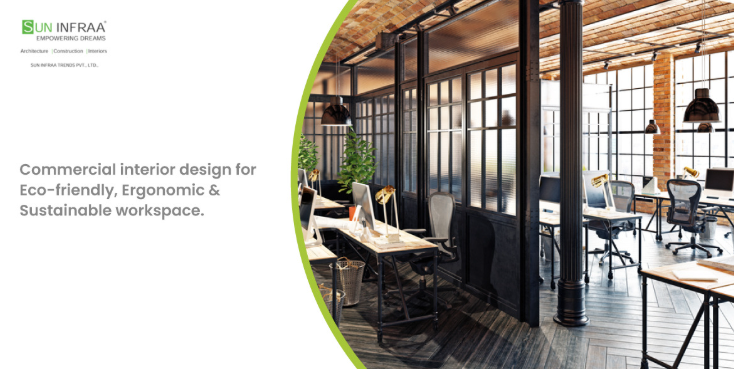Commercial interior design for Eco-friendly, Ergonomic & Sustainable workspace
As businesses evolve, so does the need for workplaces that prioritize sustainability, employee well-being, and efficiency. Modern commercial interior design is no longer just about aesthetics; it’s about creating an environment that supports both people and the planet. An eco-friendly, ergonomic, and sustainable workspace can enhance productivity, reduce environmental impact, and contribute to long-term business success.
Key Elements of an Eco-Friendly Workspace
1. Sustainable Materials and Furnishings
Choosing the right materials is fundamental to designing an eco-friendly office. Opt for:
- Recycled and Upcycled Materials – Desks, chairs, and partitions made from reclaimed wood, recycled metal, or repurposed plastic help reduce waste.
- Low-VOC (Volatile Organic Compound) Paints and Finishes – Traditional paints release harmful chemicals into the air, whereas low-VOC alternatives improve indoor air quality.
- Sustainably Sourced Wood – Certifications like FSC (Forest Stewardship Council) ensure that wood is harvested responsibly.
- Eco-Friendly Flooring – Bamboo, cork, or recycled carpets offer durability and sustainability without compromising style.
Using these materials not only reduces the office’s carbon footprint but also promotes a healthier indoor environment.
2. Energy Efficiency and Smart Technology
An energy-efficient workspace reduces electricity consumption and lowers utility bills. Key strategies include:
- LED Lighting – Consumes significantly less energy than traditional bulbs and lasts longer.
- Motion Sensor Lighting – Automatically turns off lights in unoccupied areas, reducing waste.
- Smart Thermostats – Regulate office temperature efficiently, adapting to real-time needs.
- Energy-Efficient Appliances – Laptops, printers, and HVAC systems with ENERGY STAR certification consume less power.
Integrating smart technology optimizes energy use, creating a more cost-effective and sustainable workspace.
3. Biophilic Design and Natural Elements
Biophilic design connects indoor spaces with nature, improving employee well-being and productivity. Ways to incorporate nature into office design include:
- Indoor Plants – Boost air quality, reduce stress, and enhance aesthetics.
- Living Green Walls – Serve as natural air filters while adding a striking visual element.
- Water Features – Create a calming atmosphere and reduce workplace stress.
- Large Windows and Skylights – Maximize natural light, reducing reliance on artificial lighting.
By integrating biophilic elements, offices become more inviting, energizing, and healthier for employees.
Ergonomics: Designing for Employee Well-Being
A workspace should support employees’ physical health and comfort, preventing strain and injuries. Key ergonomic principles include:
1. Adjustable Workstations
Providing height-adjustable desks allows employees to switch between sitting and standing, reducing the risk of back pain and promoting better posture.
2. Ergonomic Seating
Office chairs should:
- Support the lower back
- Have adjustable height and armrests
- Encourage proper posture
Investing in quality ergonomic furniture improves employee focus and reduces workplace fatigue.
3. Optimal Lighting Design
Proper lighting reduces eye strain and headaches. Key lighting strategies include:
- Task Lighting – Adjustable desk lamps for focused work
- Daylight Optimization – Positioning workstations near windows
- Warm, Soft Lighting – Reduces glare and enhances comfort
Lighting plays a crucial role in productivity, mood, and overall well-being.
4. Noise Control and Acoustics
A well-designed acoustic environment minimizes distractions and promotes concentration. Solutions include:
- Sound-absorbing panels
- Carpets and curtains to reduce noise reflection
- Quiet zones for focused work
- White noise machines to mask background sounds
By controlling noise levels, businesses create a more peaceful and productive workplace.
Conclusion
Creating an eco-friendly, ergonomic, and sustainable workspace is not just a trend—it’s a necessity for businesses that care about the environment and their employees. By integrating sustainable materials, energy-efficient technology, ergonomic design, and biophilic elements, companies can build a workspace that enhances well-being, boosts productivity, and aligns with corporate social responsibility goals.



